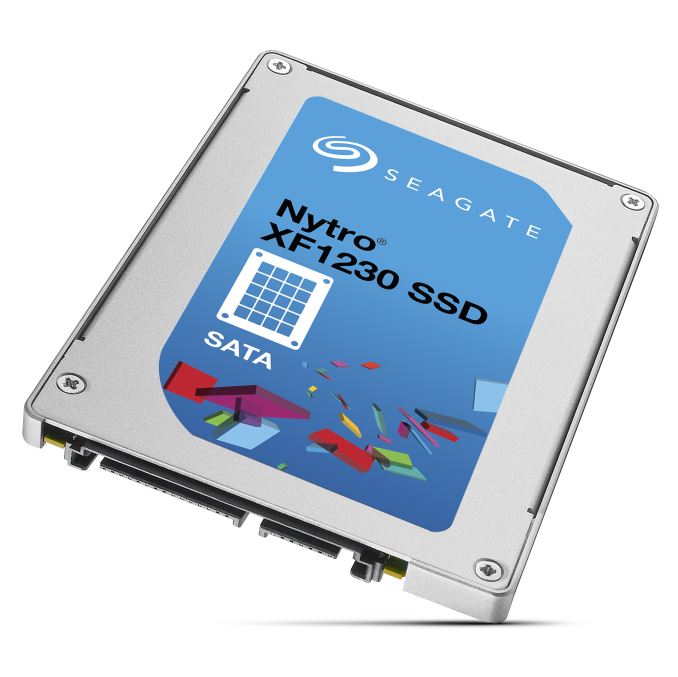Seagate Re-Enters Enterprise SATA SSD Market with Nytro XF1230
by Billy Tallis on August 4, 2016 8:00 AM EST- Posted in
- SSDs
- Storage
- Seagate
- SATA
- Enterprise SSDs

It's hard for any new SATA SSD to be big news. Aside from instances where new NAND flash enables higher capacities or a big price drop, almost everything we see is an incremental improvement where performance in particular doesn't increase much from one generation to the next. The new Seagate Nytro XF1230 enterprise SATA SSD is notable not for its technical specifications, but for who's selling it. Seagate has been absent from the SATA SSD market for quite a while since the 600 and 600 Pro SSDs were discontinued, but now they're getting back in the game.
The Seagate Nytro XF1230 is intended for use with read-intensive workloads but its use of eMLC NAND flash also gives it decent write performance and endurance. Seagate isn't disclosing who their partners are for the NAND or the SSD controller, but the combination of Micron NAND and Marvell controllers has been working well for Seagate lately in the PCIe space.
| Seagate Nytro XF1230 Series Specifications | |||||
| Capacity | 240GB | 480GB | 960GB | 1920GB | |
| Form Factors | 2.5" 7mm | ||||
| Controller | unspecified | ||||
| NAND | unspecified eMLC | ||||
| Seq Read | 560 MB/s | ||||
| Seq Write | 290 MB/s | 500 MB/s | 460 MB/s | 430 MB/s | |
| 4K Rand Read (QD32) | 98K IOPS | ||||
| 4K Rand Write (QD32) | 8K IOPS | 15K IOPS | 16K IOPS | 17K IOPS | |
| Max Power | 2.9W | 3.9W | 4.7W | 4.8W | |
| Endurance | 0.5 DWPD | 0.6 DWPD | 0.67 DWPD | 0.67 DWPD | |
| Warranty | Five Years | ||||
The drive writes per day ratings are about twice the usual for read-oriented SSDs, which broadens its scope of appeal slightly. The steady-state random write performance is not record-breaking but is reasonable for this kind of product. As with virtually all enterprise SSDs, the XF1230 includes full power loss protection, but encryption support is not advertised.
The Seagate Nytro XF1230 is in mass production now and is sampling to Seagate partners.










13 Comments
View All Comments
jabber - Thursday, August 4, 2016 - link
Hmmmm....much of a muchness.Lazlo Panaflex - Thursday, August 4, 2016 - link
Wat?I'm still rocking a 600 (non-pro) 240 gigger in my gaming rig. Great little drive.
Chaitanya - Thursday, August 4, 2016 - link
Whats DWPD? never heard of that measure.Billy Tallis - Thursday, August 4, 2016 - link
Drive Writes Per Day. Normalizing against drive capacity makes it easier to compare drives of different capacity than if you only look at total bytes written rating. Enterprise drives typically range from 0.3 DWPD for read-oriented SSDs to 3 or 10 for the most heavily overprovisioned SSDs for write-intensive workloads.Riordan - Thursday, August 4, 2016 - link
DWPD is nice for comparatives across a drive family, but awful for comparatives to other manufacturers (since it incorporates warrantied years). ShopBLT looks to have the 1.92TB version coming in at ~$700?!?Paper spec comparisons...
Samsungs PM863 1.92TB (current economical enterprise 'read' king)
Cost: ~$900
Endurance: 2.8 PBW
Seq Read: 510 MB/s
Seq Write: 475 MB/s
Rand Read: 99k IOPS
Rand Write: 18k IOPS
I hope we may have a contender. Samsung needs someone else pushing them in the budget enterprise SSD market.
stephenbrooks - Thursday, August 4, 2016 - link
I prefer just "drive writes". E.g. your 2.8 PBW / 1.92TB = 1458 drive writes.Riordan - Thursday, August 4, 2016 - link
I like that method as well since drive size is fairly basic when comparing drives. Anything that basically means, this drive will last X before it dies. DWPD is basically saying this drive will last X before it dies... for a specific amount of time that requires you to do further research on the length of the warranty if you wish to compare our number to another drive made by someone else using a different warranty length. ;)Samus - Thursday, August 4, 2016 - link
So basically they are making their own OCZ Intrepid, likely same controller, just using Micron instead of Toshiba NAND. I wonder if it will be the same Marvell eMLC reference design as the 3700, sans the replaceable cap?Penti - Thursday, August 4, 2016 - link
Why not just use their SAS-drives? 12Gb/s SAS variant should be faster too. I'm sure there's lot's of other drives to choose from for those that want to use SATA drives for storage.Riordan - Thursday, August 4, 2016 - link
Agreed, there wouldn't be any reason to drop from SAS to SATA, except the manufacturers are pricing them in a way that creates a reason. Seagate's closest 1.92GB SAS equivalent is priced over $2k. Considering the cost of storage in the enterprise world, going SATA with shorter server life cycles can save quite a bit if you don't absolutely need the IOPS benefit of SAS. That said, the number of SATA SSD options that are not exorbitant in price or anemic in endurance is still kinda small. This drive is borderline anemic in endurance for the enterprise 'read' category, but it is still one to watch.